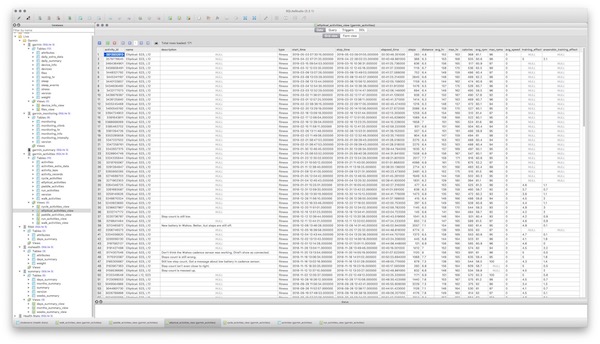Python scripts for parsing health data into and manipulating data in a SQLite DB. SQLite is a light weight DB that requires no server.
What they can do:
- Automatically download and import Garmin daily monitoring files (all day heart rate, activity, climb/decend, stress, and intensity minutes) from the user's Garmin Connect "Daily Summary" page.
- Extract sleep, weight, and resting heart rate data from Garmin Connect and import it into the DB.
- Download and import activity files from Garmin Connect. A summary table for all activities and more detailed data for some activity types. Lap and record entries for activities.
- Import Fitbit daily summary CSV files (files with one summary entry per day).
- Import MS Health daily summary CSV files and MS Health Vault weight export CSV files.
- Summarizing data into a common DB with tables containing daily summaries, weekly summaries, and monthly summaries.
- Retain data as JSON files or FIT files so that the DB can be regenerated without connecting to Garmin.
Once you have your data in the DB, I recomend using a SQLite browser like SQLite Studio for browsing and working with the data.
The scripts are automated with Make. Run the Make commands in a terminal window. You may need to reconfigure the file and directory paths in the makefile variables.
- Git clone GarminDB repo. Get the command from the green button on the project home page.
- Run
make setupget the scripts ready to process data. - Run
make GC_DATE=<date to start downloading data from> GC_DAYS={number of days of data to download} GC_USER={username} GC_PASSWORD={password} build_dbs. - Keep all of your local data up to date by running only one command:
make GC_USER={username} GC_PASSWORD={password}. - Run
make backupto backup your DBs.
More usage
- If you get a DB version exception, the DB schema was updated and you need to rebuild your DBs by running
make GC_USER={username} GC_PASSWORD={password} rebuild_dbs. - The scripts were developed on OSX. Information or patches that on using these scripts on other platforms are welcome.
- Running the scripts on Linux should require little or no changes.
- I'm not sure what it would take to run these scripts on Windows. Installing the Ubuntu subsystem on Windows 10 is one possibility. Using a Linux container is another possibility.
- If you have issues, file a bug here on the project. See the Issues tab at the top of the project page.
